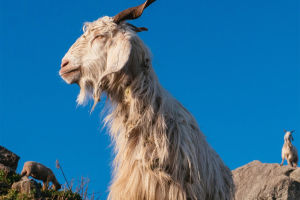Monkey
Monkey is a general term for some primates. In a narrow sense, monkeys are all species of the suborder Anthropoid primate except anthropoid.
In fact, in the scientific sense, the monkey is not a strict taxon. Monkeys are found in Asia, Africa, and Europe, as well as in the New World of America.
This geographical isolation allowed monkeys in each region to evolve independently.
The oldest known primate or the world's oldest monkey is the Atlas monkey. Based on ten isolated cheek teeth and a larval tooth fragment from the Upper Paleocene of Morocco.
The teeth show similarities to those of more monkey forms and primates. But they're more like primates. The Atlas monkey was identified as a member of the genus Eoscilloscope Monkey. It was a small animal, about the size of a modern mouse lemur, and weighed only about 50-100 grams.
Except for some protomonkeys, which are nocturnal, most monkeys are active during the day. Most monkeys are arboreal animals, but they also travel to the ground. Both high and on the ground, it is very flexible.
Some monkeys can swim. They usually start their activities in the early morning before people get up, looking for food and water. Near noon, when the weather gets hot, the monkeys take refuge in the shade and shelters to begin their lunch break.
Wait until the weather cools down in the afternoon before resuming activities and feeding. They get ready to rest before the sun goes down.
During the day, they also deal with sudden dangers and natural enemies, defend and escape. Species that live at higher elevations sometimes make seasonal group migrations.
Most monkeys are omnivorous, mainly plant, food selection and feeding methods are not completely the same. Most species eat plant foods that are high in fiber.
Monkey food from the gum, fungi to fruit, branches, and leaves, from insects, bird eggs to lizards, and even other animal children are their prey. According to the habitat and habits of different species, different monkeys have different feeding habits. The smaller marmosets prefer SAP and insects.
The cynomolgus monkeys that live near the sea will pick up crabs and other seafood at the sea. Langur monkeys and colobus monkeys, which live in tall, dense rainforests, feed mainly on leaves. Some fierce monkeys also hunt small monkeys and antelope calves.
Not only in scientific research and medical experiments, but monkeys have also been helpful in all aspects of human life since ancient times.
Clever monkeys can be trained to perform all kinds of circus and acrobatics or to work for humans. Some groups train capuchin monkeys to help quadriplegics and others with severe spinal nerve injuries or mobility impairments.
The monkeys were first acclimated to home life in human society before being sent to patients. At home, the monkey will help with some housework. Like putting food in the microwave, or cleaning a patient's face.
Many studies have shown that primates have developed brains, complex cognitive abilities, and stable social structures.
Their behavior, organizational structure, physiological and metabolic characteristics, and even the diseases they suffer are surprisingly similar to human beings.
From the perspective of molecular genetics, the genes of monkeys and humans can be 93% similar, while orangutans are 98% to 99% similar.
When it comes to monkeys, many people confuse them with apes. But they're not the same. They're quite different.
1. Monkeys are much lower in biological classification than apes. In other words, apes are more like humans than monkeys.
2. Apes are bigger than monkeys and their hands are longer than their legs.
3. Apes have no callose in their tails, cheek pouches, or buttocks, but gibbons have warts on their haunches. Monkeys have all these structures. So a monkey is a tailless primate, and an ape is a tailless primate.
4. An ape's arms are longer than its legs, while a monkey's arms are generally about the same length as its legs. The range of motion of the upper arm of the ape is significantly larger than that of the monkey.
For example, when walking upright, apes can raise their upper arms, while monkeys cannot. Apes can walk in an upright position. The monkey walks on all fours.
When walking on all fours, the hips and shoulders of the monkey form a horizontal plane, while the shoulders of the ape are significantly higher than the hips.
5. Apes generally have more developed brain capacity and intelligence than monkeys. Other aspects of apes' physiology, shape, and behavior are also closer to humans than monkeys.
6. Apes mature later than monkeys and have longer reproductive intervals, so apes are not as fertile as monkeys.


